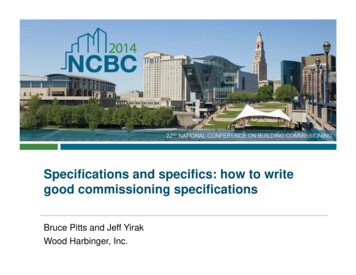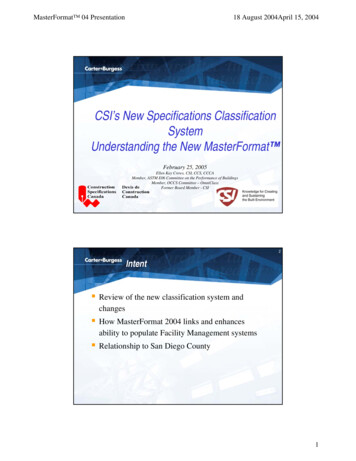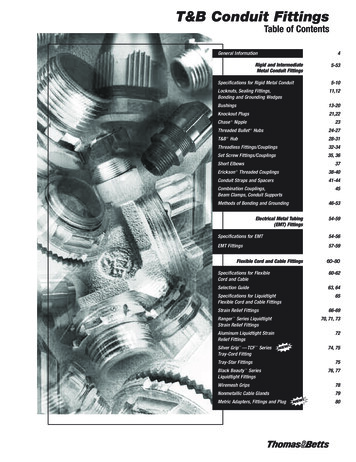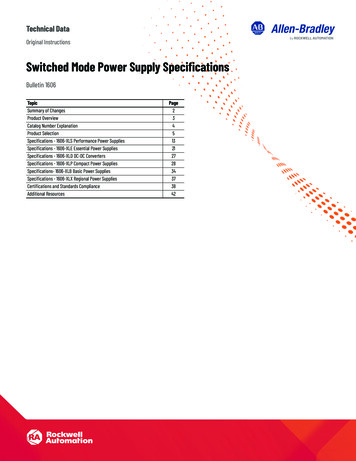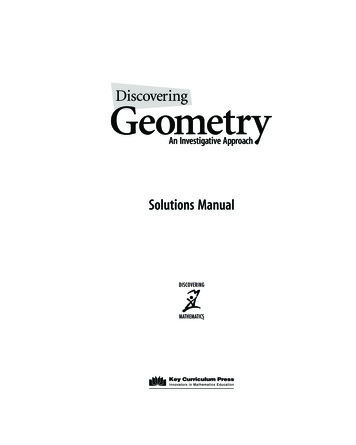
Transcription
NRMCA Publication 2PE004-21Guide to ImprovingSpecifications forReady Mixed Concrete2021 2021 National Ready Mixed Concrete AssociationAll rights reserved
NRMCA Publication 2PE004-21Guide to Improving Specifications forReady Mixed Concrete2021ForewordThis publication has been developed by the National Ready Mixed Concrete Association and itsmembers through the Research Engineering and Standards (RES) Committee. This document evolvedbased on comments developed when reviewing project specifications used in the concreteconstruction industry. This publication is intended as a guide for ready mixed concrete or contractorpersonnel who are responsible for compliance with project specifications or for design professionalwho develop project specifications. This document proposes specification clauses and includesaccompanying commentary as guidance. The commentary essentially emphasizes the fundamentalconcepts of specifications for ready mixed concrete addressed in industry standards published by ACIor ASTM International. Provisions of ACI 318-19, Building Code for Structural Concrete, as it relates torequirements concrete ingredient materials and mixtures, production and delivery are incorporatedin this document. Requirements in this document are consistent with those addressed in ACI 301-20,Specification for Concrete ConstructionThis publication uses the most recent version of the AIA MasterSpec format, Section 033000 for Castin-place concrete to provide context to the typical sections seen in project specifications of privatedesign firms or owners. The document only covers those sections pertinent to concrete materials andmixtures. It does not include or discuss sections pertinent to reinforcement, formwork or otherproducts and construction means and methods. This publication is not written as a guide or referencespecification. The intent of writing this publication in this format is to provide advisory information todesigners, contractors, concrete producers, and other stakeholders on a project to discuss the intentor for the designers to incorporate these suggestions. It is anticipated that this publication will beupdated as standards evolve or with feedback, which is encouraged.Address comments to: NRMCA Engineering Division, 66 Canal Center Plaza, Ste. 250, Alexandria, VA22314.DisclaimerThis publication is intended for the use of professional personnel, competent to evaluate the significance and limitationsof its content, and who will accept responsibility for the application of the material it contains. The National Ready MixedConcrete Association and the other organizations cooperating in the preparation of this publication strive for accuracy butdisclaim any and all responsibility for application of the stated principles or for the accuracy of the sources.Unless otherwise indicated, all materials on these pages are copyrighted by the National Ready Mixed ConcreteAssociation or cooperating organizations. All rights reserved. Therefore, reproduction, modification or retransmission, inany form is strictly prohibited without prior written permission from the National Ready Mixed Concrete Association. 2021 National Ready Mixed Concrete Association.
4
NRMCA Publication 2PE004Guide to Improving Specifications for Ready Mixed Concrete2021SECTION 033000 – CAST-IN-PLACE CONCRETEPART 1 – GENERAL1.11.21.31.41.51.61.71.81.91.101.11RELATED DOCUMENTSSUMMARYDEFINITIONSPREINSTALLATION MEETINGSACTION SUBMITTALSINFORMATIONAL SUBMITTALSQUALITY ASSURANCEPRECONSTRUCTION TESTINGDELIVERY, STORAGE, AND HANDLINGFIELD CONDITIONSWARRANTYPART 2 – CRETE, GENERALCONCRETE MATERIALSFIBER REINFORCEMENTVAPOR RETARDERSFLOOR AND SLAB TREATEMENTSLIQUID FLOOR TREATMENTSCURING MATERIALSRELATED MATERIALSREPAIR MATERIALSCONCRETE MIXTURES, GENERALCONCRETE MIXTURESCONCRETE MIXINGPART 3 – ON OF EMBEDDED ITEMS3.4INSTALLATION OF VAPOR RETARDER3.5JOINTS3.6CONCRETE PLACEMENT3.7FINISHING FORMED SURFACES3.8FINISHING FLOORS AND SLABS3.9INSTALLATION OF MISCELLANEOUS CONCRETE ITEMS3.10CONCRETE CURING3.11TOLERANCES3.12APPLICATION OF LIQUID FLOOR TREATEMENTS3.13JOINT FILLING3.14CONCRETE SURFACE REPAIRS3.15FIELD QUALITY CONTROL3.16PROTECTIONThis list of contents is based on AIA MasterSpec, version 12/18. This publication only covers discussion on all or some ofthe articles in the sections identified in bold font. These sections are pertinent to ready mixed concrete.
6
NRMCA Publication 2PE004-21: Guide to Improving Specifications for Ready Mixed ConcreteSECTION 03300 – CAST-IN-PLACE CONCRETEPART 1 – GENERAL1.1RELATED DOCUMENTS Retain or delete this article in all Sections of Project Manual. A. Drawings and general provisions of the Contract, including General and SupplementaryConditions and Division 01 Specification Sections, apply to this section Provide pertinent list of reference standards as used in the following specification fromstandards setting organizations such as ACI, ASTM International, AASHTO, etc. Include thedate of the standard in the document designation. Referenced documents that are incorporated as part of this specification and Contract Documents need to bewritten in mandatory language. Referenced standards, such as ASTM standards, should include the date ofadoption because they are revised often. In some cases, it may be necessary to reference version of standardsreferenced in the locally adopted building code. Non-mandatory language documents, such as guides, guide specifications, state-of-the-art reports orrecommended practices should not be referenced in a project specification. Guide documents written in nonmandatory language; they often have several alternative recommendations; and they often do not require anyspecific action. If the intent of a specific reference is not clear, enforcement of this intent is subject tointerpretation and opinion. Many ACI documents such as ACI 302R, 304R, 305R, 306R, 311R, and 347R are guidedocuments and are not written in mandatory language. These should not be included in the list of referencedstandards section or referenced for compliance in the body of the specification. If there are specific items in theseguides that the specification writer intends to use, these should be written into the specification in mandatorylanguage so that the requirements and responsibilities are clearly defined. General statements requiring compliance with building codes and reference specifications should be avoided.The introduction to the ACI 318-19 Building Code states: General references requiring compliance with the Code inthe project specifications should be avoided since the contractor is rarely in a position to accept responsibility fordesign details or construction requirements that depend on a detailed knowledge of the design. It is recognizedthat specific portions of the design can be delegated to a specialty engineer employed by the contractor –common for precast concrete members. Design-build projects also typically have responsibility for design andconstruction by the same entity. ACI 318 indicates that specifications and contract documents should contain allthe necessary requirements to ensure that construction is in compliance with the Code. Ensuring compliance withthe construction requirements of the Building Code is the responsibility of the design professional who is in aposition to know the design requirements, detailing, and applicable exposure conditions for all concretemembers. The applicable requirements should be stated in the project specifications. In 318-19, Chapter 26collects all construction requirements that must be incorporated in construction documents as applicable to theproject. The requirements are split into “design information” and “compliance requirements”. Design informationincludes project-specific requirements based on the design of the structure; compliance requirements areconstruction-related requirements to provide an acceptable level of construction quality. Requirementsapplicable to the project should be included in project specifications or drawings. A comprehensive list of Coderelated requirements for concrete mixtures that must be addressed in construction documents is included in26.4.2 of ACI 318-19. Section 26.13 of ACI 318-19 includes inspection requirements to be used in the absence ofgeneral building code inspection provisions. Inspection requirements are intended to provide verification that theWork complies with the construction documents. Inspection requirements of the governing jurisdiction or thegeneral building code take precedence over those included in Section 26.13 of ACI 318. Reference specifications, such as ACI 301, can be incorporated by reference in project specifications. The date ofthe referenced specification needs to be included. ACI construction specifications, such as ACI 301, has amandatory requirements checklist that includes items that the design professional has to state in contractdocuments to make the reference specification complete. Do not copy individual sections, parts, articles, orparagraphs into the project specifications because taking them out of context may change their meaning. Do not1August 2021
NRMCA Publication 2PE004-21: Guide to Improving Specifications for Ready Mixed Concreterefer to section numbers in a reference specification because of the loss of context and flow. ACI referencespecifications, such as ACI 301, establish default requirements and have optional requirements checklists thatadvise the designer on alternatives. ACI reference specifications, such as ACI 301 permit the contractor to submita written alternative to any requirement in the specification.1.2SUMMARYA. Section includes cast-in place concrete, including concrete materials, mixture design,placement procedures, and finishes.B. Related Requirements Retain subparagraphs below to cross-reference requirements Contractor might expect to findin this Section but are specified in other Sections 1. Section 031000 “Concrete Forming and Accessories” – for form-facing materials, formliners, insulating concrete forms, and waterstops2. Section 032000 “Concrete Reinforcing” – for steel reinforcing bars and welded-wirereinforcement.3. Section 033300 “Architectural Concrete” – for general building applications ofspecially finished formed concrete.4. Section 033543 “Polishing Concrete Finishing” – for floors scheduled to receive apolished concrete finish5. Section 035300 “Concrete Topping” – for emery- and iron-aggregate concrete floortoppings6. Section 321000 “Earth Moving” – for drainage fill under slabs-on-ground.7. Section 321313 “Concrete Paving” – for concrete pavement and walks.8. Section 321316 “Decorative Concrete Paving” for decorative concrete pavement andwalks.1.3DEFINITIONSA. Cementitious Materials: materials that have cementing value if used in grout, mortar, orconcrete, including portland cement, blended hydraulic cements, expansive cement, fly ash,raw or calcined natural pozzolan, ground glass pozzolan, slag cement, and silica fumeB. Water-to Cementitious Materials Ratio (w/cm): ratio of mass of water, excluding thatabsorbed by aggregate, to the mass of cementitious materials in a mixture, stated as adecimal.1.4 All cementitious materials, including portland and blended cements, and supplementary cementitiousmaterials are included in the calculation of w/cm The mixing water content in a mixture includes batch water (water weighed or metered at a plant), ice, freemoisture on aggregates, wash water retained in the mixer before batching, water added at the jobsite or byan automated truck mixer system, and water introduced from admixtures if the quantity added increases thew/cm by more than 0.01 (ASTM C94/C94M)PREINSTALLATION MEETINGSA. Conduct a pre-concreting meeting at [Location] at least [period] before first placement.1. Representatives of the following entities concerned with cast-in-place concrete arerecommended to attend:a. Architectb. Structural Engineer2August 2021
NRMCA Publication 2PE004-21: Guide to Improving Specifications for Ready Mixed Concretec.d.e.f.g.h.i.General Contractor/Construction ManagerInstaller (Concrete subcontractor)Reinforcing Steel ContractorPost-tensioning ContractorPumping ContractorManufacturer (Ready-mixed concrete producer)Independent testing agency2. Review the following:a. Concrete mixtures – specification and constructability requirementsb. Scheduling and details for placementc. Contact information of responsible persons during placementd. Placement procedures and rate of placemente. Jobsite adjustments permitted and decision processf. Cold and hot weather requirementsg. Concrete protectionh. Concrete inspection and field quality controli. Testing frequency, sampling location,j. Initial curing facilities and site access for strength test and other specimensk. Field-cured cylinders curing and intent of results NRMCA and American Society of Concrete Contractors have published the Checklist for the Concrete PreConstruction Conference. Pre installation conference is essential for major and/or complex concreteinstallations. Decisions made should be documented and distributed to stakeholders. These meetings helpminimize misunderstandings, allow for a review of specification requirements or project conditions andfacilitate resolution of problems during construction. Contact information of all stakeholders should beexchanged to facilitate seamless communication and address contingencies during construction. It is recommended that these meetings be scheduled at least 30 days prior to each major class of concreteplaced. Multiple meetings may be required.1.5ACTION SUBMITTALSA. Product Data for each of the following, if used for concrete mixtures:1. Portland cement2. Blended Hydraulic cement3. Fly ash4. Slag cement5. Silica Fume6. Natural or other pozzolanic materials7. Mineral Fillers8. Aggregates9. Admixtures “Action submittals” are those representing products or materials that require review and approval by the A/E.“Informational submittals” (Sec 1.6) are used to represent compliance with contract requirements that are notwithin the scope of work for the project. This type of submittal includes items like warranties, quality controlcertifications, and information to support the work, but is not part of it. Informational submittals are usuallykept as record documents and typically does not require a response from the designer.3August 2021
NRMCA Publication 2PE004-21: Guide to Improving Specifications for Ready Mixed Concrete Product data for materials used in concrete typically represent mill test reports and can include additionalinformation or test results required by the specification.B. Sustainable Design Submittals There are wide range of concepts used for sustainable design. More information on sustainability of concreteis available at www.nrmca.org/sustainability.C. Concrete Mixtures: For each concrete mixture, submit the following:1. Mixture Identification by class2. Type and source information on concrete materials proposed for use including:a. Cementitious Materialsb. Aggregatesc. Mineral Fillersd. Admixturese. Waterf. Fibers, color pigments, and other additions3. Compressive strength, ƒ c, applicable for the class4. Required average compressive strength, ƒ cr, for each class of concrete5. Documentation of strength test records of similar class of concrete used to establishstandard deviation in accordance with ACI 301, when test records exist6. Documentation of compliance with ƒ cr of proposed mixture(s) and test age7. Strength of concrete at other specified ages8. The applicable durability exposure classes for each class of concrete.9. w/cm of proposed concrete mixtures, when specified10. Nominal maximum aggregate size or Size number (ASTM C33) of coarse aggregate11. Target slump or slump flow12. Air content of concrete assigned to Exposure Classes F1, F2, and F313. Density, if specified14. Documentation of compliance with maximum limits on supplementary cementitiousmaterials for concrete assigned to Exposure Class F315. Cementitious materials and documentation of tests or service for concrete assigned toExposure Class S1, S2, and S316. Documentation on chloride content of concrete mixtures for conformance to limits inExposure Class C – calculated total chloride or measured water-soluble chlorides byASTM C1218/C1218M, expressed as a percentage of cementitious materials.17. Documentation on alkali aggregate reactivity for concrete assigned to Exposure ClassW1 or W2, as specified18. Intended placement method19. Equilibrium density of lightweight concrete and correlated density of fresh concrete, ifspecified20. Documentation supporting other specified requirements of concrete mixtures21. Intended placement method22. Anticipated changes to concrete mixtures for anticipated routine variability of inmaterials, and changes in project conditions, weather, test results, or othercircumstances that warrant adjustments4August 2021
NRMCA Publication 2PE004-21: Guide to Improving Specifications for Ready Mixed Concrete These submittal items are drawn from a list that the designer must include in construction documents relatedto concrete mixtures from Section 26.4 in ACI 318-19. These are related to Code requirements for concretemixtures for strength and durability. Some additional items are included. Some of these items may not beapplicable to a specific project and should be modified based on project requirements. In a performancebased specification some of these prescriptive items would be replaced by performance-based requirements.Details regarding acceptance criteria of performance-based requirements should be stated in thisspecification. The mixture proportioning process of establishing the required average strength based on the specifiedstrength used in design has been eliminated from ACI 318-19. Article 4.2.3 of ACI 301 for establishing therequired average strength for proposed concrete mixtures. ACI 301 establishes the required average strength, ƒ cr, for a concrete mixture proposed for the project to beestablished based on:1. Strength test record exists: In this case, the standard deviation from a strength test record of a similar classof concrete produced under similar conditions is used to calculate the required average strength. Thespecified strength, ƒ c, of the similar class should be within 1000 psi of that for the proposed Work. Thestrength test record cannot be more than 24 months old and has to have been collected over a period notless than 45 days.2. Strength test record does not exist: If there is no strength test record of a similar class of concrete, therequired average strength, ƒ cr, is at a given increment above the specified strength, ƒ c. The incrementvaries from 1000 psi to (1.1 ƒ c 700) psi depending on the level of ƒ c.Case 2 results in a larger value for the required average strength than the first case. A fixed over-design valueshould not be specified as a default requirement for establishing ƒ cr. Proportioning a concrete mixture for arequired average strength based on the standard deviation is preferred if a strength test record for that classof concrete exists. The use of an unnecessary higher level of required strength should be avoided as it cancause unintended consequences related to higher heat of hydration (due to a higher quantity of cementitiousmaterials) and increased shrinkage that increase the potential for cracking and curling of concrete slabs.If Case 2 is used to establish ƒ cr to start a project, the designer should permit a reduction of the level ofstrength after at least 15 strength tests are collected and the standard deviation of that test record is used toindicate that a lower required average strength can be used. This requires a submittal of the revised mixtureproportions to achieve the reduced level of average strength.The concrete producer may need to make adjustments to concrete mixtures during the course of a projectwhen strength tests fail the acceptance criteria or when trends indicate a potential for failure. The designermay require that these adjustments have to be submitted for acceptance. The concrete supplier submits information on the proposed concrete mixture documenting that it will achievethe established required average strength and other specification requirements. This can include:1.2.Field data: Field test records of at least 10 consecutive strength tests of the proposed class of concretedocumenting the strength equals or exceeds the established ƒ cr, including documentation that it meetsother specification requirements. This test record can be different from that used to determine thestandard deviation. It should be permitted to interpolate information from two sets of field test recordsof similar classes of concrete to establish the water-cementitious materials ratio or cementitious materialcontent for the classes of mixtures for proposed Work.Laboratory trial mixture data: ACI 301 permits the concrete supplier to interpolate using three or more trialmixtures varying w/cm or cementitious materials content to arrive at the proportions of the proposedmixture.Laboratory trial mixtures can be used even if the ƒ cr, was established using the standard deviation method todocument that the proposed mixture will satisfy the specified requirements. It is also acceptable to document5August 2021
NRMCA Publication 2PE004-21: Guide to Improving Specifications for Ready Mixed Concretethe characteristics of a proposed mixture by producing a batch of at least 3 cu. yd. in the concrete productionfacility.Laboratory trial batch evaluation should not be required when a satisfactory field test record exists.ACI 318-19 requires that trial mixture data should have been developed within 24 months of submittal. Thetime restriction for test records applies only to strength tests. Some durability tests require a longer lead timeand older data should be considered acceptable if similar materials are used. The specification should not require laboratory trial batches to be prepared by an independent laboratory.This should be at the option of the concrete supplier. When the concrete supplier has laboratory facilities,documentation of concrete mixtures for submittals is best accomplished in those facilities. The concretesupplier has the best knowledge of the ingredient materials used and the ability to optimize their use todevelop mixture proportions for a mixture submittal. Ultimately the acceptance criteria on a project governover the submittal and an inappropriate submittal represents a significant risk to the concrete supplier andthe project. A guide to submittal of concrete mixture proportions is provided in ACI 211.5R. A recommended format is inAppendix B of this document. If the specification includes performance-based requirements, the submittal information should be pertinentto compliance with the performance requirements of the specification. Documentation of concrete materialquantities and other details of mixture proportions may not necessarily indicate such compliance. Acertification of concrete mixtures signed by a professional engineer and test record and other prequalificationperformance data linked to the mixture identification should suffice as the submittal to the designprofessional. It is appropriate to require information about the concrete materials to demonstrate compliancewith applicable material specifications. Development of optimized performance-based mixtures involvessignificant cost and effort by concrete suppliers and the resultant mixtures represent their proprietaryintellectual property. Public disclosure of such information can impact their competitiveness. If mixtureproportions of performance-based concrete are required to be submitted because of contractualrequirements, this information should be retained by the owner’s representative under a confidentialityagreement with the manufacturer. The designer’s review of the submittal of concrete mixtures for compliance with the project requirementsshould be the responsibility of the engineer of record or a qualified delegate. Review of the submittal could include verification that the concrete mixture certification is signed and sealedby a licensed engineer; include verification that it demonstrates compliance with certified requirements; andincludes specific properties that can be verified during construction. These can include slump or slump flow,air content, density, temperature or other properties. Some of these can be used as indicators that themixture delivered is similar to that in the submittal. The density of fresh concrete is a good measure of batchto-batch uniformity and is useful for detecting batching errors. Some of the fresh concrete properties should be selected by the contractor and producer unless it isspecifically required by the design professional for approving the construction means and methods. Thesecharacteristics can include slump and its adjustment, setting characteristics, finishability characteristics,characteristics for pumping mixtures, air content adjustments to accommodate placement methods, etc. Thedesigner should avoid specifying a slump requirement as it might impact the ability to place the concrete. ACI301 indicates slump selection by the contractor and the established value be documented in the submittal.Characteristics of fresh concrete recommended by the contractor, such as slump, may be used as a measureof consistency of concrete furnished to the project. (Item 12) The required air content of concrete depends on anticipated exposure of the concrete member andthe nominal maximum size of the coarse aggregate. Air content should be as required for the applicableExposure Class for Exposure Category F. It is permitted to reduce the air content by 1 percentage point fromthe table values for specified strength equal to or exceeding 5000 psi. This recognizes that air content resultsin a greater reduction of strength for higher strength and can increase the content of cementitious materialsto achieve the required strength. Additionally, higher strength concrete has reduced porosity, which reducesits potential for becoming saturated with water that affects freeze thaw resistance. Exterior vertical members6August 2021
NRMCA Publication 2PE004-21: Guide to Improving Specifications for Ready Mixed Concretecan be assigned to Exposure Class F1 that requires a lower air content because these are unlikely to becomesaturated in service. (Item 14) The maximum limits on supplementary cementitious materials (SCMs) should only be specified formembers assigned to Exposure Class F3. These types of members are not common in buildings. The quantityof SCMs in blended cements needs to be known and this will limit the amount of additional SCMs that can beused. (Item 15) For Exposure Category S, besides using cementitious materials listed in ACI 318-19 Table 19.3.2,mixtures with SCMs that improve sulfate resistance as documented by previous service record or ASTM C1012results are permitted. (Item 16) Water-soluble chloride limits are stated on the basis of total cementitious material content.Compliance with the chloride limits can be done by either the calculated chloride content based on thechloride content of constituent materials and mixture proportions; or a water-soluble chloride contentmeasured in accordance with ASTM C1218/C1218 at an age of 28 to 42 days. (Item 17) Documentation for alkali-silica reactivity can include test results indicating that the aggregatesproposed for use are non-reactive. If aggregates are reactive, mitigation may include using a minimumquantity of fly ash or slag cement as determined by testing in accordance with ASTM C1567 or the calculatedalkali content in the concrete in lb./yd3 can be documented to be less than specified limits provided in ACI301. Only the alkali from portland cement is used in this calculation. More detail on alkali aggregate reactivityis covered in practice ASTM C1778. Consider defining the period of time for retention of batch records of individual concrete deliveries forforensic purposes (3-5 years from delivery date). Ready mixed concrete companies have internal policies forretention of records. The contractor might have requirements for uniform setting characteristics of deliveries of concrete batches.These requirements can be established by the producer and concrete contractor along with a means to verifythis requirement. This can impact the changing types and dosage of admixtures depending on environmentalconditions.D. Shop DrawingsE. Samples:F. Concrete Schedule: For each type of concrete mixtures indicated in Article C, include thefollowing:1. Mixture Designation by Class2. Location with Project3. Exposure Class Designation4. Other details on finishes, curing process, floor treatment, if any1.6INFORMATIONAL SUBMITTALSA. Qualification Information1. Installer: Include applicable ACI Certificates2. Ready mixed concrete manufacturer3. Testing agency retained by the contractor for field quality control: Include conformanceto ASTM C1077 or ASTM E329 and copies of ACI certificates of testing techniciansB. Concrete Mixture Certification: For each class of concrete:1. Signed and sealed by professional engineer licensed in the state of the Project.2. Documentation of test results indicating compliance with specified requirements foreach concrete mixture3. Identity characteristics of each mixture that will be used for quality assurance duringconstruction7August 2021
NRMCA Publication 2PE004-21: Guide to Improving Specifications for Ready Mixed Concrete Certification of concrete mixtures by an independent licensed engineer for compliance with specificationrequirements can be used for performance-based specifications. This review can cover documentation of testdata for different requirements for all clas
A comprehensive list of Code-related requirements for concrete mixtures that must be addressed in construction documents is included in 26.4.2 of ACI 318-19. Section 26.13 of ACI 318-19 includes inspection requirements to be used in the absence of gene




